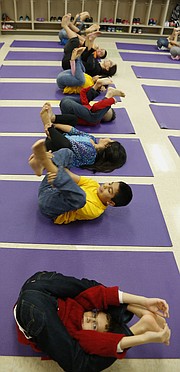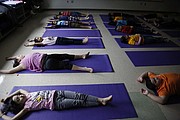Promoting student health with yoga
ERICKA MELLON/Houston Chronicle | Hagadone News Network | UPDATED 10 years, 4 months AGO
HOUSTON (AP) - In a window-lit classroom at Crockett Elementary School, 21 third-graders sat cross-legged on purple mats and put their hands over their hearts.
"How does exhaling feel?" their teacher, Morgan Camp, asked.
"Relaxing," said one boy.
"Like bubbles going in and then they're popping by themselves," said another.
Camp led the youngsters through 45 minutes of breathing exercises and yoga poses - with some giggling along the way - in a new class meant to promote lifelong wellness and fitness, calming techniques and increased focus in academic courses.
With obesity rates too high and exercise participation too low, particularly among minorities, the yoga-based health and wellness classes are coming to a dozen campuses in the Houston Independent School District this fall thanks in part to a grant from the California-based Sonima Foundation. The nonprofit donated at least $360,000 for the program.
"We want healthier, happier kids. That's the bottom line," Gill McClean, a yoga mentor with the Sonima Foundation, told the Houston Chronicle.
Nationally, about 17 percent of children and adolescents aged 2 to 19 are obese, according to the Centers for Disease Control and Prevention. The rates were higher for Hispanic and black youth, 22 percent and 20 percent, respectively, and lower for whites, at 14 percent.
A survey of HISD middle school students found similar disparities, with black and Hispanic children less likely to be physically active and more likely to watch TV and play video games. Overall, 42 percent of the students surveyed last year said they were physically active for at least 60 minutes per day on five or more days in the last week.
As trendy and pricey yoga studios have popped up around the country, nonprofits like the Sonima Foundation and New York's Bent on Learning have brought the mind-body practice to public schools. Still, special yoga courses in schools aren't widespread as administrators balance academic requirements with electives.
"Lots of physical education teachers do incorporate some yoga into their classes," said Dolly Lambdin, president of the Society of Health and Physical Educators and a clinical professor at the University of Texas at Austin. "It's a great activity for people. But it's only one piece of what a quality physical education program should be."
In HISD, the yoga wellness classes come in addition to regular P.E. classes in some cases, and replace them in others. Ten elementary schools, one middle and one high school are participating in the program.
The curriculum from the Sonima Foundation includes a series of yoga poses plus lessons in character education, like being kind and mindful.
A bulletin board in Camp's classroom displays vocabulary words like "intention," "posture," "compassion" and "discipline."
Camp began a class last week by asking her third-graders to remove their socks and shoes and walk quietly to their spots.
"Remember the agreement," she told them. "You cannot step on anyone else's mat."
Camp later guided them through a series of moves, including downward-facing dog - or "dog tails in the air," as she called it.
"You feel warm?" Camp asked.
Most of the students, wearing regular pants and T-shirts or long sleeves, raised their hands.
After class, 8-year-old Kenell Ramirez gave yoga a thumbs up. He said he felt "a little bit tired and happy."
"This is the best class," added Julia Franco, 8. "Yoga's like doing the splits, but you don't feel the pain in your legs."
Camp sees the third- and fifth-graders twice a week, and the other students once a week. At Crockett, a school that specializes in fine arts, her class serves as the sole P.E. course, though some students also take dance and they all get daily recess.
In just a few weeks, Camp said, her students seem more relaxed and conscious of their feelings. Some of the dancers have told her their flexibility has improved, and those who play instruments have said their hands are less sore thanks to the stretches.
"It's a combination of P.E. and health," Camp said. "We're not playing soccer outside, but it's definitely improving hand-eye coordination. The need to exercise is being met."
Texas law says public elementary school students should get 135 minutes a week - or 27 minutes a day - of "moderate or vigorous physical activity." Middle school students are supposed to take four semesters of physical education, and high school students need two semesters.
The participating HISD schools will be part of an ongoing study conducted by the University of San Diego's Center for Education Policy and Law.
Scott Himelstein, director of the center, said the study already found positive results from the first year of the Sonima Foundation's launch in San Diego County.
Despite an unsuccessful lawsuit alleging the program was religious in nature, Himelstein said teachers in Encinitas reported that students in the yoga classes were more focused, and the children fared better on the state's fitness test in flexibility and core strength than those in the control group.
With national pressure to raise standardized test scores, Himelstein said he thinks the yoga wellness program could help low-performing schools if it gives students "strategies for calming themselves, for being able to focus, for being able to deal with some of the stressful situations that may be in some lower socioeconomic areas."
The Sonima Foundation, looking to expand to a district with a large underserved population, turned to HISD Superintendent Terry Grier, who used to work in San Diego. About 80 percent of HISD's students last year were low-income, and 87 percent were black or Hispanic.
Tiffany Chenier, the principal of HISD's McNamara Elementary, said she hopes the yoga wellness program helps her youngsters learn to self-regulate - to energize themselves and reduce their stress.
"Believe it or not, we have little children who are anxious about taking a test," Chenier said. "They can do a de-stressing exercise. These are just habits we need for life."
She said she hopes to start an after-hours class for her staff next.
"When they learned we were having it for the boys and girls, immediately they asked, 'What about us?'" she said.
ARTICLES BY ERICKA MELLON/HOUSTON CHRONICLE

Promoting student health with yoga
HOUSTON (AP) - In a window-lit classroom at Crockett Elementary School, 21 third-graders sat cross-legged on purple mats and put their hands over their hearts.












